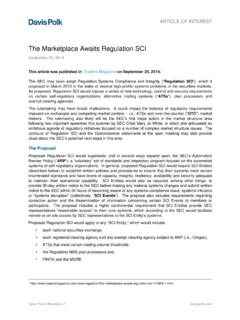Transcription of Equity - Davis Polk & Wardwell
1 Chapter introduces selected US legal issues raised by Equity derivativetransactions. An understanding of these issues requires a basic understanding of thebusiness issues presented by the transactions themselves, as well as the surroundingbusiness are Equity derivatives?Derivatives are financial instruments that derive their value from the value ofsomething else, such as interest rates, commodities or derivatives arederivatives that derive their value from the value of underlying Equity securities. Equityderivatives generally transfer the risks and benefits of owning the underlying securitiesfrom one party to another, thereby allowing parties to gain or dispose of economicexposure to the underlying Equity securities.
2 Thus, Equity derivatives effectively enabletheir users to buy and sell Equity securities synthetically. The particular securitiesunderlying an Equity derivative can be Equity securities of a single issuer, an equityindex or a basket of Equity securities of various issuers or Equity indices. This chapterfocuses principally on Equity derivatives that relate to shares of common stock tradedin the US Equity dealer and its hedging activitiesBanks, broker-dealers or other financial intermediaries (for the sake of simplicity, theterm dealer is used to mean any such entity) enter into Equity derivatives to providetheir end-user clients with the ability to gain synthetic long or short exposure toparticular underlying shares.
3 As derivatives involve a transfer of economic exposurefrom one party to the other, the dealer that is a party to an Equity derivativetransaction will have exposure on the opposite side of the market to the dealer sclient. For example, if a dealer writes a swap or an option to an end user that resultsin the end user being long the underlying shares, the transaction will necessarilyresult in the dealer having short exposure. Generally, dealers that are party to thesetransactions are not motivated by a particular directional view as to the value of theunderlying shares. Therefore, dealers will generally try to hedge their exposure to the139 Equity derivatives:selected US legal issuesWitold Balaban, John M Brandow, James T Rothwell and Joyce Y Xu Davis Polk & Wardwell1 The legal issues discussed in this chapter are raised primarily by transactions that relate to Equity securities (including American depositary receipts) traded in the US Equity John C Hull, Options, Futures & Other Derivatives(6th Ed, 2006) at p with permission from Globe Business Publishing, copyright shares so that their net economic position is neutral.
4 For example, in an Equity derivative transaction in which the end user issynthetically selling the underlying shares to the dealer, the economic risks andbenefits of owning the shares are transferred from the end user to the dealer. Thedealer s economic position in the transaction is long that is, its value moves in thesame direction as the value of the underlying shares, increasing as the value of theunderlying shares increases and decreasing as the value of the underlying sharesdecreases. To hedge its long position, the dealer will need to enter into a transactionor transactions that provide the dealer with an offsetting short position; this type ofhedge is referred to as a short hedge.
5 The most common short hedge is a short sale,which involves borrowing shares in the stock loan market and selling them in thecash short hedge could also take the form of a sale of futures contracts orcall options, a purchase of put options or a short swap position. In contrast, in a transaction in which the dealer is synthetically selling shares tothe end user, the economic risks and benefits of owning the shares are transferred fromthe dealer to the end user. The dealer s economic position in such a transaction will be short that is, its value moves in the opposite direction as the value of the underlyingshares, decreasing as the value of the underlying shares increases and increasing as thevalue of the underlying shares decreases.
6 To hedge its short position, the dealer willneed to enter into a transaction or transactions that provide the dealer with anoffsetting long position; this type of hedge is referred to as a long hedge. The mostcommon long hedge involves buying shares in the cash market, but a long hedge couldalso take the form of a purchase of futures contracts or call options, a sale of putoptions or a long swap position. This chapter focuses principally on hedging by buyingor selling shares in the cash generally hedge derivatives using proprietary models based onmathematical properties of the derivative. One such property, delta , measures theamount by which the derivative increases or decreases in value for a given change inthe value of the underlying shares (or, in mathematical terms, the first derivative ofthe value of the derivative contract as a function of the value of the underlyingasset).
7 For example, consider a derivative contract relating to nshares. If the valueper underlying share changes by xdollars, the value of the contract would change byan amount equal to the product of n, x and the delta of the contract. The delta of aderivative itself changes over time and as the value of the underlying shares (andother factors) change. Dealers determine the value of derivative contracts usingproprietary option valuation models that apply inputs such as the strike price of theoption embedded in such contract, the market value of the underlying shares, theprice volatility of the shares, dividends and interest rates and the remaining term ofthe derivatives: selected US legal issues1403A short sale creates an economic short position because of the borrowed shares.
8 The dealer musteventually return shares to the share lender. If the value of the shares increases, the dealer will need topay more to purchase those shares in the market to return to the share lender (referred to as covering the short position) than it received in proceeds from the sale of the borrowed shares, so the dealer willlose money on the transaction as the value of the shares increases. Conversely, the dealer will be able tocover its short position more cheaply if the share price decreases, so the dealer will make money on thetransaction as the value of the shares with permission from Globe Business Publishing, copyright order to have a neutral net position with respect to an Equity derivativecontract, the value of the dealer s hedge position at any time must completely offsetthe value of the contract to the dealer at such time.
9 Thus, in order to hedge a longposition under an Equity derivative contract relating to nshares, the dealer willestablish and maintain a short hedge position consisting of a number of shares equalto the product of nand the delta of the contract. For example, if the contract relatesto 100 underlying shares and has a delta of , the dealer s short position will be 80shares. As a result, if the value of the shares increases by one unit, the value of thecontract will increase by 80 units (one unit per share multiplied by 100 sharesunderlying the contract multiplied by the delta of ) and the value of the shortposition will decrease by 80 units (one unit per share multiplied by 80 shares short),so that the dealer s net position remains neutral.
10 As the delta of the contract changesover time, the dealer will adjust its hedge position accordingly by buying or sellingshares, so that its hedge position remains neutral and it neither gains nor loses, on anet basis, when the stock price dealer s long or short hedge position of the initial delta of a derivative transactionis often referred to as the dealer s initial hedge . The dealer s subsequent adjustments ofits hedge position to match the changes in the delta of the contract over the term of thetransaction are often referred to as dynamic discussions that follow focus on the US legal issues presented by differenttypes of common Equity derivative transaction. Many of the legal issues that arise inequity derivative transactions relate to the dealer s hedging activity.









